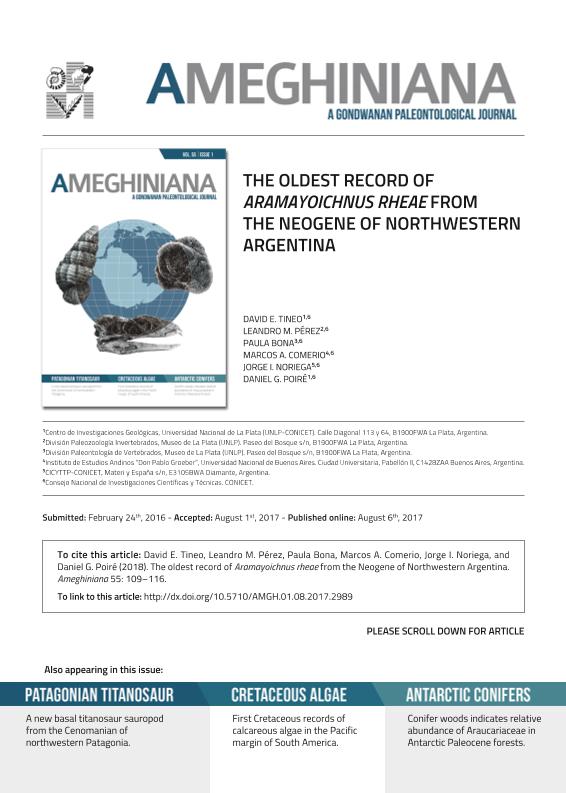Mostrar el registro sencillo del ítem
dc.contributor.author
Tineo, David

dc.contributor.author
Pérez, Leandro Martín

dc.contributor.author
Bona, Paula

dc.contributor.author
Comerio, Marcos

dc.contributor.author
Noriega, Jorge Ignacio

dc.contributor.author
Poire, Daniel Gustavo

dc.date.available
2019-07-23T22:48:36Z
dc.date.issued
2018-02
dc.identifier.citation
Tineo, David; Pérez, Leandro Martín; Bona, Paula; Comerio, Marcos; Noriega, Jorge Ignacio; et al.; The Oldest Record of Aramayoichnus rheae from the Neogene of Northwestern Argentina; Asociacion Paleontologica Argentina; Ameghiniana; 55; 1; 2-2018; 109-116
dc.identifier.issn
0002-7014
dc.identifier.uri
http://hdl.handle.net/11336/80130
dc.description.abstract
THE Argentinean fossil record of vertebrate footprints is significant and has been extensively studied; however, sites with bird tracks are scarce and less known (Bonaparte, 1965; Aramayo, 1991, 2007; Galli et al., 1992; Aramayo and Manera de Bianco, 1987, 1990, 1996; de Valais and Melchor, 2008; Genise et al., 2009; Melchor, 2009; Alonso, 2012; Aramayo et al., 2015). Although there are some studies of fossil footprints referred to Aves, there are no detailed descriptions or taxonomical assignations of such traces. A bird trackway with three footprints was found in the lower levels of the Guandacay Formation (upper MiocenePliocene) (Ayaviri, 1967), Grupo Chaco (Stebinger, 1920; White, 1925), at the “Río Iruya” section, 62 Km NW of the city of San Ramón de la Nueva Orán (Salta Province, Argentina; Fig. 1.1). This unit is part of the fill of the Neogene foreland basin of Sierras Subandinas Australes. This Subandean terrain is a thin-skinned fold-thrust belt system which represents the easternmost expression of the deformation of the central Andes. Compressive tectonics created a foreland basin with clastic sequences of continental rocks of approximately 7500 m of thickness (Hernández et al., 1996; Ramos, 1999). The aim of this contribution is to report a new record of Aramayoichnus rheae Aramayo et al., 2015, from the Neogene of Northwestern Argentina, based on tridactyl footprints attributed to bird activity. This fossil evidence expands the paleogeographical and temporal distribution of this ichnospecies, showing the presence of rheids in the Late Miocene of the Subandean region. The footprints were preserved as natural casts (convex hyporeliefs) in brownish-grey, fine to medium grain conglomerates; the base of the level is in contact with reddishreddish brown mudstones and very fine sandstones (Fig. 1.2). The hypothesis that a rheiform bird could have registered this trackway is herein considered in association with the fossil record of the group in a stratigraphic and biogeographic context.
dc.format
application/pdf
dc.language.iso
eng
dc.publisher
Asociacion Paleontologica Argentina

dc.rights
info:eu-repo/semantics/openAccess
dc.rights.uri
https://creativecommons.org/licenses/by-nc-sa/2.5/ar/
dc.subject
Argentina
dc.subject
Guandacay Formation
dc.subject
Ichnology
dc.subject
Rheidae
dc.subject
Salta Province
dc.subject.classification
Paleontología

dc.subject.classification
Ciencias de la Tierra y relacionadas con el Medio Ambiente

dc.subject.classification
CIENCIAS NATURALES Y EXACTAS

dc.title
The Oldest Record of Aramayoichnus rheae from the Neogene of Northwestern Argentina
dc.type
info:eu-repo/semantics/article
dc.type
info:ar-repo/semantics/artículo
dc.type
info:eu-repo/semantics/publishedVersion
dc.date.updated
2019-07-23T13:01:14Z
dc.identifier.eissn
1851-8044
dc.journal.volume
55
dc.journal.number
1
dc.journal.pagination
109-116
dc.journal.pais
Argentina

dc.journal.ciudad
Ciudad Autónoma de Buenos Aires
dc.description.fil
Fil: Tineo, David. Consejo Nacional de Investigaciones Científicas y Técnicas. Centro Científico Tecnológico Conicet - La Plata. Centro de Investigaciones Geológicas. Universidad Nacional de La Plata. Facultad de Ciencias Naturales y Museo. Centro de Investigaciones Geológicas; Argentina
dc.description.fil
Fil: Pérez, Leandro Martín. Consejo Nacional de Investigaciones Científicas y Técnicas; Argentina. Universidad Nacional de La Plata. Facultad de Ciencias Naturales y Museo. División Paleozoología Invertebrados; Argentina
dc.description.fil
Fil: Bona, Paula. Consejo Nacional de Investigaciones Científicas y Técnicas; Argentina. Universidad Nacional de La Plata. Facultad de Ciencias Naturales y Museo. División Paleontología Vertebrados; Argentina
dc.description.fil
Fil: Comerio, Marcos. Consejo Nacional de Investigaciones Científicas y Técnicas. Oficina de Coordinación Administrativa Ciudad Universitaria. Instituto de Estudios Andinos "Don Pablo Groeber". Universidad de Buenos Aires. Facultad de Ciencias Exactas y Naturales. Instituto de Estudios Andinos "Don Pablo Groeber"; Argentina
dc.description.fil
Fil: Noriega, Jorge Ignacio. Provincia de Entre Ríos. Centro de Investigaciones Científicas y Transferencia de Tecnología a la Producción. Universidad Autónoma de Entre Ríos. Centro de Investigaciones Científicas y Transferencia de Tecnología a la Producción. Consejo Nacional de Investigaciones Científicas y Técnicas. Centro Científico Tecnológico Conicet - Santa Fe. Centro de Investigaciones Científicas y Transferencia de Tecnología a la Producción; Argentina
dc.description.fil
Fil: Poire, Daniel Gustavo. Consejo Nacional de Investigaciones Científicas y Técnicas. Centro Científico Tecnológico Conicet - La Plata. Centro de Investigaciones Geológicas. Universidad Nacional de La Plata. Facultad de Ciencias Naturales y Museo. Centro de Investigaciones Geológicas; Argentina
dc.journal.title
Ameghiniana

dc.relation.alternativeid
info:eu-repo/semantics/altIdentifier/url/http://www.ameghiniana.org.ar/index.php/ameghiniana/article/view/2989
dc.relation.alternativeid
info:eu-repo/semantics/altIdentifier/doi/https://doi.org/10.5710/AMGH.01.08.2017.2989
dc.relation.alternativeid
info:eu-repo/semantics/altIdentifier/url/https://bioone.org/journals/Ameghiniana/volume-55/issue-1/AMGH.01.08.2017.2989/The-Oldest-Record-Of-Aramayoichnus-rheae-from-the-Neogene-of/10.5710/AMGH.01.08.2017.2989.short
Archivos asociados
